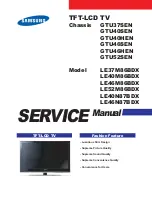
8
IC block diagram
1. TVP5160
The TVP5160 device is a high quality, digital video decoder that digitizes and decodes all popular
baseand analog video formats into digital component video. The TVP5160 decoder supports the
A/D conversion of component YPbPr and RGB (SCART) signals, as well as the A/D conversion and
decoding of NTSC, PAL, and SECAM composite and S-Video into component YCbCr. Additionally,
component progressive signals can be digitized. The chip includes two 11-bit, 60-MSPS, A/D
converters (ADCs). Prior to each ADC, each analog channel contains an analog circuit, which
clamps the input to a reference voltage and applies a programmable gain and offset. A total of 12
video input terminals can be configured to a combination of YPbPr, RGB, CVBS, and S-Video video
inputs.
Progressive component signals are sampled at 2x clock frequency (54 MHz) and are then
decimated to the1x rate. In SCART mode the component inputs and the CVBS inputs are sampled
at 54 MHz alternately, then decimated to the 1x rate. Composite or S-Video signals are sampled at
4x the ITU-R BT.601 clock frequency (54 MHz), line-locked for correct pixel alignment, and are then
decimated to the 1x rate. CVBS decoding utilizes advanced 3D Y/C filtering and 2-dimensional
complementary 5-line adaptive comb filtering for both the luma and chroma data paths to reduce
both cross-luma and cross-chroma artifacts. 3D Y/C color separation may be used on both PAL and
NTSC video signals. A chroma trap filter is also available. On CVBS and Y/C inputs, the user can
control video characteristics such as hue, contrast, brightness, and saturation via an I2C host port
interface. Furthermore, luma peaking with programmable gain is included, as well as a patented
color transient improvement (CTI) circuit. Attenuation at higher frequencies or asymmetrical color
subcarrier sidebands are compensated using the IF compensation block. Frame adaptive noise
reduction may be applied to reduce temporal noise on CVBS, S-Video, or component inputs.
3D noise reduction and 3D Y/C separation may be used at the same time or independently.
The TVP5160 decoder utilizes Texas Instruments’ patented technology for locking to weak, noisy,
or unstable signals and can auto-detect between broadcast quality and VCR-style (nonstandard)
video sources.
The TVP5160 decoder generates synchronization, blanking, field, active video window, horizontal
and vertical syncs, clock, genlock (for downstream video encoder synchronization), host CPU
interrupt and programmable logic I/O signals, in addition to digital video outputs.
The TVP5160 decoder includes methods for advanced vertical blanking interval (VBI) data retrieval.
The VBI data processor (VDP) slices and performs error checking on teletext, closed caption, and
other VBI data. A built-in FIFO stores up to 11 lines of teletext data, and, with proper host port
synchronization, full-screen teletext retrieval is possible. The TVP5160 decoder can pass through
the output formatter 2x sampled raw Luma data for host-based VBI processing.
Digital RGB overlay can be synchronously switched with any video input, with all signals being
oversampled at 4x the pixel rate.
Summary of Contents for LC-32U26
Page 1: ...LCD TELEVISION LC 32U26 ...
Page 11: ...9 ...
Page 12: ...10 ...
Page 15: ...13 4 MSP3425G ...
Page 24: ...AV OUT board ...
Page 25: ...key board ...
Page 26: ...32 power board ...
Page 27: ...IR board ...
Page 28: ...MCU CPU board page1 of 8 ...
Page 29: ...LVDS BK CPU board page2 of 8 ...
Page 30: ...POWER CPU board page3 of 8 ...
Page 31: ...SDRAM CPU board page4 of 8 ...
Page 32: ...TVP5160 CPU board page5 of 8 ...
Page 33: ...YPbPr AUDIO SWITCH CPU board page6 of 8 ...
Page 34: ...CPU board page7 of 8 ...
Page 35: ...CPU board page8 of 8 ...
Page 36: ...video board page1 of 2 ...
Page 37: ...video board page1 of 2 ...
Page 41: ...603 L32U260 18 Ver 1 0 ...











































